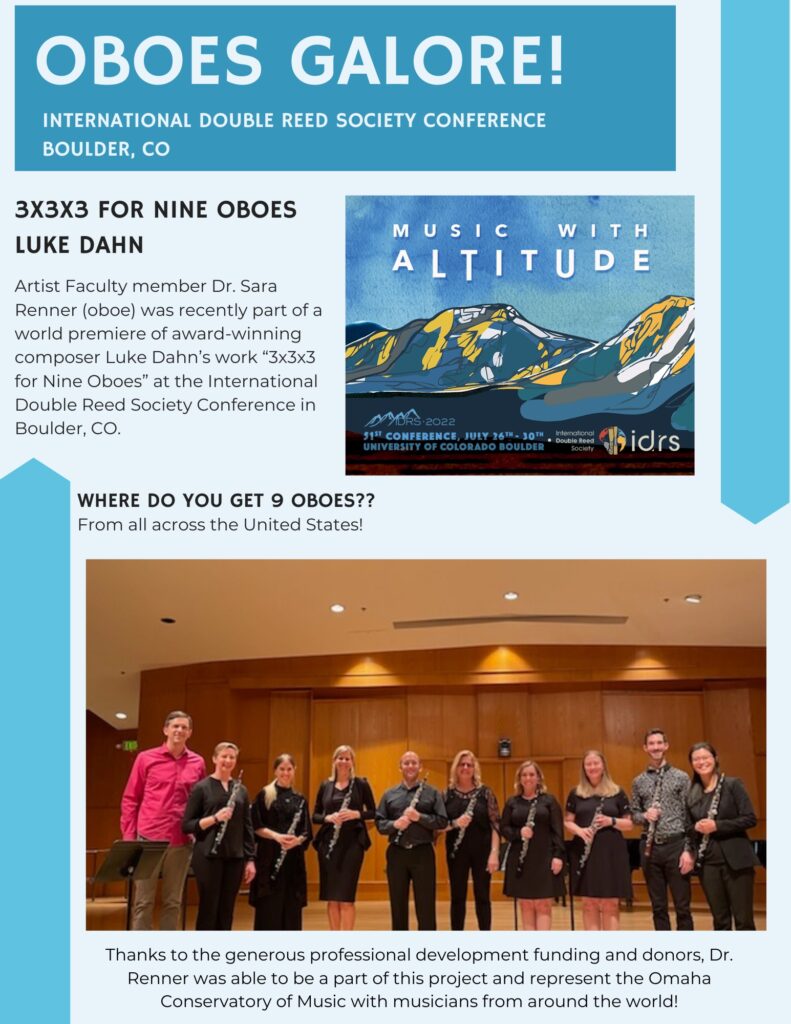August 15th, 2022 • Artist-Faculty News
Guest Blog Post: Dr. Sara Renner
Happy Tuesday! We’re so excited to have oboe/English horn Artist-Faculty member Dr. Sara Renner share her experience from the International Double Reed Society Conference in Boulder, Colorado last month. Keep reading to learn more about this event—which brought together many professional musicians and professors from all across the world—and about Sara’s participation in a world premiere of a brand new piece written for NINE oboes! Great work, Sara! Thanks for representing the Omaha Conservatory at this exciting conference!

Recently, I had the pleasure to attend and perform at the 51st International Double Reed Society Conference in Boulder, Colorado. The conference was held at the University of Colorado, and involved a week of countless performances, lectures, masterclasses, and exhibitors from oboists and bassoonists from around the world. I was part of an ensemble that premiered 3x3x3 for Nine Oboes by composer Luke Dahn with oboists from around the country. Thanks to the generous donors and OCoM’s commitment to ensuring the continual professional development of their Artist Faculty, I was able to be a part of this performance and represent the Omaha Conservatory of Music to musicians from around the world.
The piece was written in commemoration of JS Bach’s 333rd birthday in 2018. The number three is structural to the entire composition (hence the title!), even down to the tempo indication: sixteenth note=333 beats per minute. The oboes are divided into three groups of three, with each group being in canon with each other. For example, Group 1 played the exact same music, just a beat apart from each other.
The intervals of the work are also related to Bach, as they outline his name in music using the famous “B-A-C-H” motif (in German notation, B represented B flat, while H represented B natural). Bach implemented this motif himself throughout several of his fugues. Fun fact: this is known as a musical cryptogram (as in cryptography, or code)! This is a great example of modern composers use early music in new and unconventional ways, and how the genius of Bach is still impacting our music today.
Another compositional technique is the use of multiphonics: the practice of wind instruments playing multiple notes at the same time (think of double stops on strings, but with absolutely no control- or, just think of a train whistle!). Naturally, playing Oboe 1, I gave the tuning pitch as our first multiphonic!
So, how on earth do you get a piece for nine oboes performed, you ask? These conferences are some of the only times and places where this is able to happen. The ensemble was made up of professional oboists and professors from Colorado, Minnesota, Texas, Nevada, Utah, Alabama, Nebraska, and Florida. We had one rehearsal with all of us together, the day before the performance.
The composer was in attendance, and he was very pleased with the performance! It is such a unique experience performing a composer’s work FOR the composer!
Conferences are a great way to connect with other musicians, build your professional network, promote yourself and your institution, and most importantly, learn from each other and build friendships! Several people were inquiring about OCoM, and were very impressed with the work that OCoM is doing for students and for the arts.
I would like to thank the staff and donors at the Omaha Conservatory of Music for making this possible! It was a wonderful experience.
